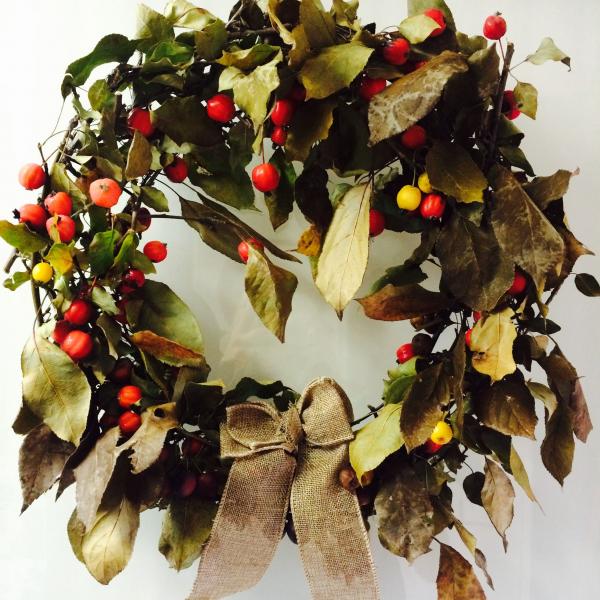
In New England, right around the start of autumn, many folks begin to adorn their front doors, fences, and yards with seasonal decorations. Pumpkins, bales of hay, stalks of corn, and a staple in the seasonal traditions, bittersweet. Wreathes and sprigs of these beautiful berries are sold along country roads, and at farmers markets, and are a tempting natural décor option. This plant is invasive, and spreads easily by seed (those same seeds that are all over those wreathes!). In this article, we’ll talk about native and non-invasive plant alternatives for natural seasonal decorations, and how you can help your local forests and fields by doing some DIY!
Background:
Asiatic Bittersweet (Celastrus orbiculatus), is a perennial vine that does not support its own weight, so it twists and twines over other plants. The leaves are oval, and have serrations along the edges. This species has separate male and female plants, and the fruit husks on the female plants are yellow when ripe, splitting open to reveal bright red pips, and occur along the whole branch at the joints. This plant is a native to East Asia, introduced to North America in the 1860s as an ornamental plant.
The ecological threat from this plant comes from its ability to grow rapidly, to great heights, in full sun or complete shade, often girdling, weighing down, or smothering the other plants that support it. In addition, it is displacing the native plant American bittersweet (Celastrus scandens). The two can be distinguished by the fact that American bittersweet has flowers and fruits only at the terminal end of each branch. Current research is working to determine the level of cross-pollination between the two, and how that impacts the survival and abundance of the native species.
DIY Project Ideas:
Here are examples of natural plant décor, collected from native or non-invasive plants found in Vermont!
--DIY Seasonal alternatives: wreathes, hangings, and centerpieces made of: wild grape, willow, pine cones, crab apples, Virginia creeper, dried wildflowers, cranberries, and evergreen bows
ex: Crab Apple Wreath (see photo)
Learn more:
--If you’d like to learn more about the biology of Asiatic bittersweet, how to ID it and the American bittersweet, and what to plant as alternatives, check out these links:
http://www.vtinvasives.org/sites/default/files/bittersweet2010.pdf
https://gobotany.newenglandwild.org/species/celastrus/orbiculatus/
https://gobotany.newenglandwild.org/species/celastrus/scandens/
--Spread the word, not the plant! Prohibited to buy, sell, or transport this plant:
http://agriculture.vermont.gov/plant_pest/plant_weed/invasive_noxious_we...
--Listed as a National Invasive Species:
http://www.invasivespeciesinfo.gov/plants/bittersweet.shtml
~~~~~~~~~~~~~~~~~~~~~~~~~~~~~~~~~~~~
Article Credit: E. Spinney, VT FPR
Photo Credit: E. Spinney, Crabapple wreath